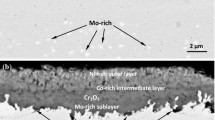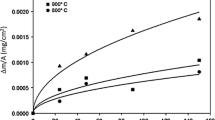Abstract
Four superalloys were subjected to cyclic oxidation and hot corrosion attack in a Mach 0.3 burner rig. Two of the alloys, HA-188 and S-57, were cobalt-base and the other two, IN-617 and TD-NiCrAl, were nickel-base. The alloys were exposed to maximum temperatures of 900 and 1000°C. For hot corrosion tests the burner rig flame was doped with various concentrations of sea salt and one concentration of sodium sulfate. Samples were evaluated based on maximum depth of attack. These data were subjected to a regression analysis for the development of model equations relating corrosion to temperature and for determining how significantly changes in salt concentration and composition affected the corrosion. The ranking of the alloys with respect to their corrosion resistance was found to vary with temperature, sea salt concentration, and salt composition. Some of the variation was attributed to changes in the mode of attack from straight oxidation to hot corrosion. Under those test conditions where the mode of attack was readily discernible S-57 was found to be the most hot corrosion-resistant alloy and TD-NiCrAl was the least resistant. This order was reversed when the attack was straight oxidation, TD-NiCrAl being the most resistant alloy and S-57 the least.
Similar content being viewed by others
References
J. Stringer, “Hot Corrosion of High Temperature Alloys,” Univ. of Liverpool, Liverpool, England, Final Report EOAD-TR-76-05 (1976) (AD A031363).
R. C. Hurst, J. B. Johnson, M. Davies, and P. Hancock, “Sulfate and Chloride Attack of Nickel-Based Alloys and Mild Steels,” inDeposition and Corrosion in Gas Turbines, A. B. Hart and A. J. B. Cutler, eds. (Wiley, New York, 1973), pp. 143–157.
J. F. G. Condé and B. A. Wareham, “Aspects of Mechanisms of Hot Corrosion in Marine Gas Turbines,” inProceedings of the 1974 Gas Turbine Materials in the Marine Environment Conference, J. W. Fairbanks and I. Machlin, eds., MCIC 75-27 (Battelle Laboratories, Columbus, Ohio, 1975), pp. 73–92.
P. Hancock, “Summation and Examination by Session Chairman of the Various Hypothesis of the Hot Corrosion Mechanism,”Proceedings of the 1974 Gas Turbine Materials in the Marine Environment Conference, J. W. Fairbanks and I. Machlin, eds., MCIC 75-27 (Batelle Laboratories, Columbus, Ohio, 1975), pp. 225–236.
C. A. Stearns, F. J. Kohl, and G. C. Fryburg, “Reactions of Chromium with Gaseous NaCl in an Oxygen Environment,” NASA TM X-73476 (1976).
G. C. Fryburg, R. A. Miller, F. J. Kohl, and C. A. Stearns,J. Electrochem. Soc. 124, 1738 (1977).
J. G. Smeggil and N. S. Bornstein, “Study of the Effects of Gaseous Environments on Sulfidation Attack of Superalloys,” NASA-CR-135348 (November 1977).
R. L. Jones and S. T. Gadomski,J. Electrochem. Soc. 124, 1641 (1977).
F. J. Kohl, C. A. Stearns, and G. C. Fryburg, “Sodium Sulfate-Vaporization Thermodynamics and Role in Corrosive Flames,” inMetal-Slag-Gas Reactions and Processes, Z. A. Foroulis and W. W. Smeltzer, eds. (Electrochemical Society, New York, 1975), pp. 649–664.
F. J. Kohl, G. J. Santoro, C. A. Stearns, G. C. Fryburg, and D. E. Rosner, “Theoretical and Experimental Studies of the Deposition of Na2SO4 From Seeded Combustion Gases,” Paper presented at the Symposium on Corrosion Problems Involving Volatile Corrosion Products, sponsored by the Electrochemical Society, Philadelphia (May 8–13, 1977). See also NASA TM X-73683 (May 1977).
A. Davin, D. Coutsouradis, and L. Habraken,Cobalt 57, 175 (1972).
G. J. Santoro, “Hot Corrosion of S-57, A Cobalt-Base Alloy,” NASA TN D-8395 (February 1977).
C. A. Stearns, F. J. Kohl, and G. C. Fryburg,J. Electrochem. Soc. 121, 945 (1974).
C. E. Lowell and W. A. Sanders, “Mach 1 Oxidation of Thoriated Nickel Chromium at 1204°C (2200°F),” NASA TN D-6562 (November 1971).
S. M. Sidik, “An Improved Multiple Linear Regression and Data Analysis Computer Program Package,” NASA TN D-6770 (April 1972).
N. R. Draper and H. Smith,Applied Regression Analysis (Wiley, New York, 1966).
N. S. Bornstein, M. A. De Crescente, and T. Sturiale, “Accelerated Sulfidation of a Nickel-Base Superalloy,” Proc. AFML 50th Anniversary Tech. Conf. Corros. Military and Aerospace Equipment, AFML-TR-67-329, Denver, Colorado (May 23–25, 1967).
D. Deadmore and C. Lowell, “Burner Rig Alkali Salt Corrosion of Several High Temperature Alloys,” Paper presented at the 151st Meeting of the Electrochemical Society, Philadelphia (May 8–13, 1977). See also NASA TM X-73659 (May 1977).
K. R. Peters, D. P. Whittle, and J. Stringer,Corros. Sci. 16, 791 (1976).
Author information
Authors and Affiliations
Rights and permissions
About this article
Cite this article
Santoro, G.J. Hot corrosion of four superalloys: HA-188, S-57, IN-617, and TD-NiCrAl. Oxid Met 13, 405–435 (1979). https://doi.org/10.1007/BF00605108
Received:
Issue Date:
DOI: https://doi.org/10.1007/BF00605108




